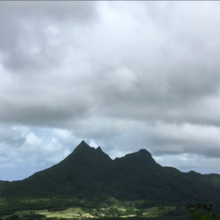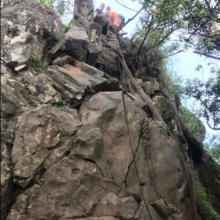Mount Olomana rises like a green fin 1,500ft out of the surrounding jungle. This striking feature, on the Hawaiian Island of Oahu, has been called, "Oahu's Matterhorn." A well-used trail wraps up the NNW ridge and involves some class 4 scrambling to reach the top. The views from the top are amazing, giving you panorama views of Kailua and Kāneʻohe Bay and across to the Koolau Ridge. This route exposes visitors to the steep, rugged nature of the volcanic Hawaiian Islands.
The FKT route starts at the edge of the paved country club road (the 'trailhead') where the trail climbs 1,500ft in just over a mile to the first peak. The Mount Olomana FKT route is an out and back. There is a Strava segment for the route: https://www.strava.com/segments/18449412
Additional route information adapted from the SummitPost page for Mount Olomana:
Park on side streets or at the parking lot before the bridge (before entering the Country Club) as you will be towed anywhere after the bridge. Then walk down the road to the golf course and check-in with the guard at the gatehouse. Usually, they'll let you just walk inside to the trailhead. Past the guard station walk down the road no more than a half mile till you see a sign to the showing the way to the trail off the paved road). The route starts at the edge of the pavement.
The trail is initially fairly flat, going through some rainforest type vegetation and passing an abandoned water station before reaching an intersection on exposed red dirt. Turn and climb the trail to climber's right, ascending the North Ridge that passes through a grove of pine-like Ironwood trees. Near the top of the first peak, you will encounter some class 3 scrambling and about a 15-foot vertical section of class 4 rock. The class 4 section will typically be protected by one or more ropes, however, these ropes are not maintained and care should be taken in using them. Some more exposed scrambling leads you to the summit of Olomana
CLIMBING CONSIDERATIONS
- All the peaks require comfort with YDS class 3 scrambling or higher.
- The rock scrambling involves ridges with drop-offs on either or both sides and caution is necessary, especially during rainy and/or windy conditions.
- Along several parts of the climb, there are often ropes, cables, and/or straps, to assist the climb, however these are not officially installed or maintained and there is no assurance of their condition. Use at your own risk and it is advisable to avoid completely weighting the ropes.
- Due to the up/down and scrambling nature of this hike, make sure you bring sufficient water. 2-3 liters is advisable.
- Typical hikers should allow about 5 hours for the full round trip to the third peak.



